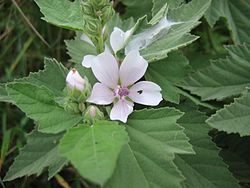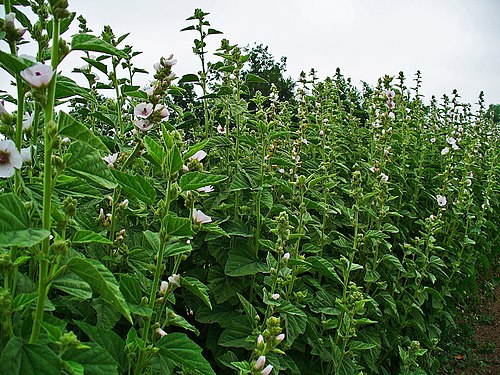Althaea officinalis
| Habit | herbaceous
| |
|---|---|---|
| Height: | ⇕ | 1.2 m"m" can not be assigned to a declared number type with value 1.2. |
| Lifespan: | ⌛ | perennial |
| Bloom: | ❀ | late summer, early fall |
| Exposure: | ☼ | sun, part-sun |
|---|---|---|
| Water: | ◍ | moist, moderate, dry |
| Features: | ✓ | deciduous, flowers, edible |
| USDA Zones: | 3 |
|
Althaea > |
L. > |
Althaea officinalis (Marshmallow, Marsh Mallow, or Common Marshmallow) is a species native to Africa, which is used as a medicinal plant and ornamental plant.
The stems, which die down in the autumn, are erect, 3 to 4 ft m high, simple, or putting out only a few lateral branches. The leaves, shortly petioled, are roundish, ovate-cordate, 2 to 3 in mm long, and about 1 1/4 inch broad, entire or three to five lobed, irregularly toothed at the margin, and thick. They are soft and velvety on both sides, due to a dense covering of stellate hairs. The flowers are shaped like those of the common Mallow, but are smaller and of a pale colour, and are either axillary, or in panicles, more often the latter.
The stamens are united into a tube, the anthers, kidney-shaped and one-celled. The flowers are in bloom during August and September, and are followed, as in other species of this order, by the flat, round fruit which are popularly called 'cheeses.'
The common Mallow is frequently called by country people 'Marsh Mallow,' but the true Marsh Mallow is distinguished from all the other Mallows growing in Great Britain, by the numerous divisions of the outer calyx (six to nine cleft), by the hoary down which thickly clothes the stems and foliage, and by the numerous panicles of blush-coloured flowers, paler than the Common Mallow. The roots are perennial, thick, long and tapering, very tough and pliant, whitish yellow outside, white and fibrous within.
The whole plant, particularly the root, abounds with a mild mucilage, which is emollient to a much greater degree than the common Mallow. The generic name, Althaea, is derived from the Greek altho (to cure), from its healing properties.
Most of the Mallows have been used as food, and are mentioned by early classic writers with this connection.
Read about Althaea officinalis in the Standard Cyclopedia of Horticulture
|
|---|
|
Althaea officinalis, Linn. Marsh Mallow. Erect, 3—4 ft., downy: Lvs. ovate, often heart-shaped or 3- lobed, frequently undivided, tomentose: fls. 1 in. across, blush or rose, clustered in the axils of the Lvs. Perennial, in marshes. E. Eu., and occurring in this country as an escape.—Root used for mucilage and for other purposes; also medicinal. The root of commerce has its brown outer covering removed. Rarely cult., but occasionally escaped in marshes near the coast.
|
Cultivation
Succeeds in almost any soil and situation[1, 4, 200], though it prefers a rich moist soil in a sunny position[4, 200]. It also tolerates fairly dry soil conditions[1]. Plants are hardy to about -25°c[187]. Marsh mallow is often cultivated in the herb garden, as a culinary and medicinal herb as well as for ornament[61]. Its roots were at one time the source of the sweet 'marsh mallow', but this sweet is now made without using the plant[4].
Propagation
Seed - sow spring or autumn in a cold frame. The seed is best sown as soon as it is ripe in late summer, the germination is often erratic[238]. Stratification can improve germination rates and time. Prick out the seedlings into individual pots when they are large enough to handle and plant them out in the summer[K]. Division in spring or autumn. Fairly easy, it is best to pot up the divisions in a lightly shaded position in a cold frame or greenhouse until they are growing away well and then plant them out into their permanent positions. Root cuttings in December.
Pests and diseases
Varieties
Gallery
References
- Plants for a Future - creative commons text incorporated
- Standard Cyclopedia of Horticulture, by L. H. Bailey, MacMillan Co., 1963
External links
- w:Althaea officinalis. Some of the material on this page may be from Wikipedia, under the Creative Commons license.
- Althaea officinalis QR Code (Size 50, 100, 200, 500)




